Introduction
Nitrogen is the most unstable element in the soil and also the nutrient that has the largest impact on maize grain yield (Cantarella, 2007). The splitting of nitrogen side-dressing fertilization at different growth stages is an alternative for enhancing the efficiency of nitrogen fertilizers and to mitigate N losses. This is possible due to the higher N uptake promoted by the syncronization between nitrogen fertilization and maize demand for the nutrient (Silva et al., 2005).
Several factors are involved in maize response to the splitting of nitrogen side-dressing fertilization: soil type, weather conditions, cropping system, sowing time, hybrid type, N source, growth stage, and the method of nitrogen application (Sangoi et al., 2016). The splitting of nitrogen side-dressing fertilization is usually recommended when high N rates are used on sandy soils and rainy conditions (Fontoura & Bayer, 2009).
Only 5% to 10% of the total nitrogen is taken up by maize until the growth stage V6, according to the scale proposed by Ritchie et al. (1993), when the growing point is transformed into a floral primordium (Sangoi et al., 2010). Nearly 75% of the total N absorbed by the plant during its cycle is concentrated between V6 and tasseling (Sangoi et al., 2016). For this reason, the commission of soil chemistry and fertility recommends that N side-dressing fertilization should be performed between the growth stages V4 and V8 in one or two applications, at the beginning of the period of greatest foliar expansion and large increments in plant height (Comissão de Química e Fertilidade do Solo, 2016).
An experiment carried out by DeBruin and Butzen (2014) in the United States of America showed that modern maize hybrids can take up 50% of total nitrogen after flowering. Therefore, late nitrogen fertilizations carried out at tas-seling may delay foliar senescence and increase the crop phostosynthetic activity during grain filling. These physiological changes may enhance kernel weight and increase grain yield. The results obtained by Kosgey et al. (2013) and Ning et al. (2014) reinforce this tendency, showing that modern hybrids have the capacity to take up and assimilate great amounts of N after flowering. Therefore, splitting nitrogen side-dressing fertilization up to tasseling may be important to maximize grain yield.
The sowing date is a determinant factor for optimizing maize agronomic performance. The choice of sowing date is specific for each production region. It is affected by environmental conditions, especially temperature, precipitation, and the availability of solar radiation. When there is no water limitation, the most favorable sowing date for maize in southern Brazil is the beginning of spring (September-October) (Serpa et al., 2012). Sowings performed between the middle of September and the middle of October favor the coincidence between flowering and the period of the year with long days, high solar radiation availability, and temperatures ranging from 20 to 30°C. This is the time when maize has maximum leaf area (Sangoi et al., 2010). Despite that, late sowings performed at the end of spring (November-December) and at the beginning of summer (December-January) are common in southern Brazil, when maize is grown after other crops with higher economic importance, such as tobacco, onion, and garlic (Forsthofer et al., 2004).
The positive effect of splitting N side-dressing fertilization up to maize tasseling may be affected by the sowing date. At late sowings, the soil and air temperatures are high during the early stages of the crop, and this stimulates the plant vegetative growth and development. However, the grain filling period will occur in late summer (February-March) and early autumn (March-April), when the temperature and solar radiation are low and less favorable to N uptake from the soil and transportation of it to the kernels. Thus, the efficiency of side-dressing part of N rate at tasseling as a strategy to increase grain yield may be compromised at late sowing dates.
This study was based on the hypothesis that the effect of splitting nitrogen side-dressing fertilization as a management strategy to improve grain yield and nitrogen efficiency use is higher when maize is sown at a favorable time, at the beginning of spring. The objective of the experiment was to assess the effect of the sowing date on maize response to the splitting of nitrogen side-dressing fertilization at different growth stages.
Materials and methods
Two field experiments were set in Lages (2015/2016) and Atalanta (2016/2017) in the State of Santa Catarina, southern Brazil. The experimental site of Lages is located at 27°50'35" S, 50°02'45" W and 849 m a.s.l. and the experimental site of Atalanta is located at 27°26'03" S, 49°42'06" W at 586 m a.s.l. The soils were classified as Distrofic red Nitossol (Lages) and Distrofic Haplic Cambisol (Atalanta) (Santos et al., 2018). The results of soil analysis performed at the plowable layer (0 to 20 cm) in August of each growing season are shown in Table 1. Maize was sown after black oat (Avena strigosa) desiccation at both experimental sites. Winter coverage was killed with an application of glypho-sate (1200 g a.i.) 45 d before each sowing date.
TABLE 1 Soil properties in the 0 to 20 cm layer of the experimental areas during the 2015/16 (Lages) and 2016/17 (Atalanta) growing seasons.

SMP - Shoemaker-McLean-Pratt; OM - organic matter; P and Kwere extracted with Mehlich-1; Ca2+, Mg2+, and Al3+ were extracted with KC11 mol L-1.
A randomized block design was used with treatments arranged in split plots and 4 repetitions. Two sowing times were tested in the main plots: preferential (beginning of spring) and late (end of spring). The preferential sowing dates were 10/15/2015 (Lages) and 09/20/2016 (Atalanta). The late sowing dates were 12/5/2015 (Lages) and 12/5/2016 (Atalanta). Six nitrogen side-dressing management treatments were assessed in the split plots: control (without N); complete N rate applied at V5 (vegetative grown stage - fifth leaf collar); complete N rate applied at V10; ½ N rate applied at V5 and ½ N rate applied at V10; ⅓ N rate applied at V5, ⅓ N rate applied at VIO; and ½ N rate applied at VT (tasseling); and complete N rate applied at VT, according to a scale proposed by Ritchie et al. (1993) (Tab. 2). Each split plot comprised four rows, with 0.7 m row spacing, 0.19 m plant spacing and 6.0 m length. All data were collected in the two central rows of each split plot, except for 0.5 m at the end of each line, in an area of 7.0 m2.
TABLE 2 Characterization of the fertilization on each sowing date and N side-dressing managements. Lages (2015/2016) and Atalanta (2016/2017).
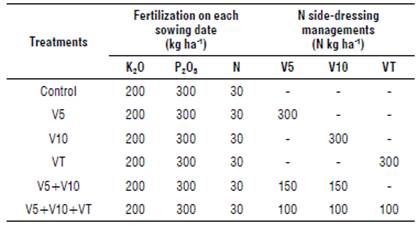
Growth stages according to the scale proposed by Ritchie et al. (1993): V5 (vegetative growth stage - fifth leaf collar); V10 (vegetative growth stage - tenth leaf collar); VT (tasseling).
The experimental areas were fertilized with a mixture of phosphorus, potassium, and nitrogen on each sowing date, based on the results of soil analyses carried out yearly and in accordance with the recommendations of the commission of soil chemistry and fertility (Comissão de Química e Fertilidade do Solo, 2016) to achieve a grain yield of 21 t ha-1. The sources used to supply N, P, and K were urea (45% N), triple superphosphate (46% P2O5), and potassium chloride (60% K2O), respectively. The rates applied at sowing were equivalent to 30 kg ha-1 N, 300 kg ha-1 P2O5, and 200 kg ha-1 K2O (Tab. 2). Fertilizers were distributed on the soil surface close to the plant rows. Nitrogen was side-dressing at a rate of 300 kg N ha-1, according to the growth stages defined for each treatment (Tab. 2). The experiment was planted by hand in a no-tillage system, with manual seeders and marked strings for a plant population of 75000 plants ha-1. The hybrid tested was P30F53YH. The experiments were irrigated to maintain soil moisture close to the field capacity (Fig. 1).
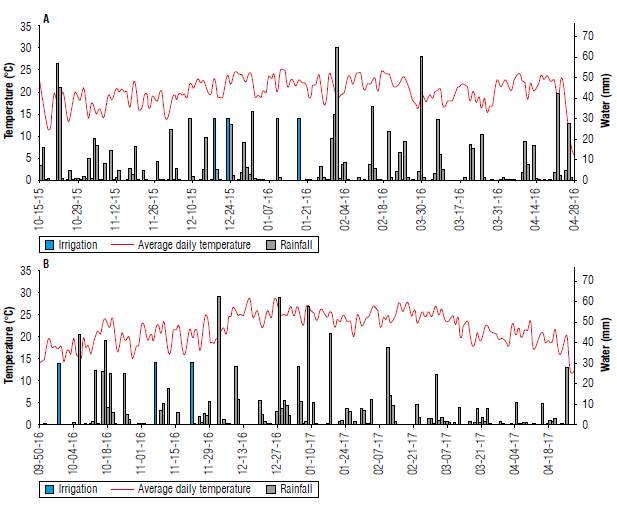
FIGURE 1 Average daily temperature, daily rainfall and irrigation of maize cycles from seedling to harvest during A) 2015/2016 (Lages-SC) and B) 2016/2017 (Atalanta-SC) growing seasons.
Weed control was carried out with two herbicide applications. The first one was performed at preemergence immediately after sowing and with a combination of atrazine (1259 g a.i. ha-1) and metolachlor (1250 g a.i. ha-1). The second application was performed after maize emergence, when plants were at V4 with tembotriona (100 g a.i. ha-1). Insects and diseases were controlled whenever necessary so that they did not to interfere with the crop development.
Green leaves were measured when maize reached the R1 growth stage (silking), to determine the leaf area and leaf area index (LAI). These determinations were repeated periodically every 14 d, up to 70 d after silking, when the kernels were physiologically ripened. Leaf area per plant (LA) was calculated using the following expression according to the method described by Borrás et al. (2003):
where L is the length of the leaf, W is the width of the leaf, and 0.75 is the correlation coefficient.
The ears were manually harvested on 04/02/2016 and 05/02/2016 in the first year, and 03/02/2017 and 04/28/2017 in the second year. The ears were mechanically threshed. The kernels were oven dried at 60°C until they had constant weight using a drying oven with circulation/air exchange (MA035/1152, Marconi, Piracicaba, SP, Brazil). Afterwards, grain yield and its components were determined and expressed at the standard moisture of 13%.
Agronomic efficiency of nitrogen use (AE) expressed in kg kg-1 was determined according to Fageria and Baligar (2005), using the following formula:
where AE is the agronomic efficiency, GYf is the fertilized grain yield, GYu is the unfertilized grain yield, and Na is the application rate of side-dressing N.
The data were examined by analysis of variance using the F test with the software ASSISTAT 7.7 (E Silva & de Azevedo, 2016). The F values were considered significant at the error probability level of 5%. When the treatment differences were significant, the means were compared by the Tukey's test. The LAI variations during grain filling were assessed by polynomial regression analysis, testing the linear and quadratic models. Average comparisons were carried out at the significance level of 5%.
Results and discussion
The leaf area index (LAI) was affected by the interaction between sowing date, nitrogen side-dressing fertilization treatment, and days after silking (Tab. 3). There was a reduction of LAI from silking to kernel physiological maturity in all six nitrogen side-dressing management treatments due to the gradual leaf senescence occurred during grain filling (Fig. 2). The LAI values at each sampling time and their rate of decrease during the sampling period of treatments with the entire N fertilization at V5 and V10 or split into two and three times were similar at both experimental sites, regardless of the sowing date. Such behavior shows that dividing side-dressing into two or three growth stages neither delayed leaf senescence nor increased the crop LAI at the end of grain filling. The control without N showed a higher decrease of LAI values whereas the treatment with all nitrogen side-dressing fertilization at VT showed the lowest decrease of this variable along the 70-day sampling period. These differences are related to the important role of nitrogen on chlorophyll formation and its effect on keeping leaves photosynthetically active for a longer period (Sangoi et al., 2016).
TABLE 3 F-values and significances according to the analysis of variance for grain yield, weight of 1000 grains, grains per ear and agronomic efficiency of N use as a function of the main effect of sowing date and nitrogen side-dressing management and agronomic efficiency of N use as a function of the main effect of sowing date, nitrogen side-dressing management and days after silking.
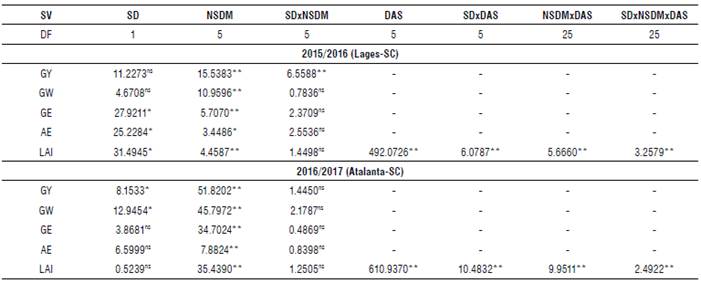
F-test. ** significant at 1% probability level (P<0.01); * significant at 5% probability level (0.01d"0.05);ns- not significant (P>0.05). SV-source of variation; SD - sowing date; NSDM - nitrogen side-dressing management; DAS-days after silking; DF-degree of freedom. GY-grain yield; GW-weight of 1000 grains; GE-grains per ear; AE-agronomic efficiency of N use. LAI-leaf area index.
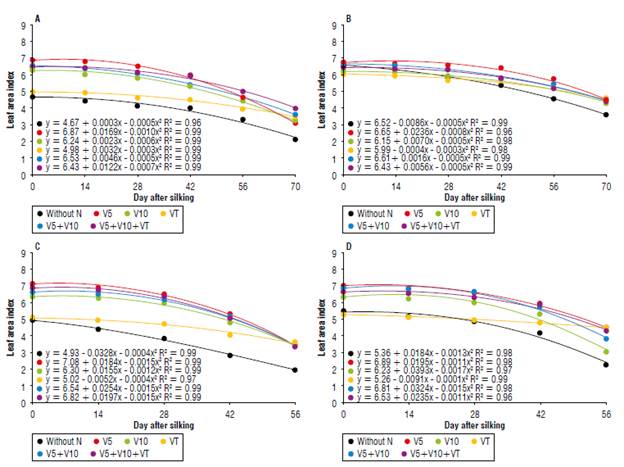
FIGURE 2 Leaf area index (LAI) during maize grain filling as affected by sowing date and nitrogen side-dressing fertilization in Lages A) 10/15/2015; B) 12/05/2015), and Atalanta C) 09/20/2016; D) 12/05/2016).
Grain yield ranged from 8.9 to 15.3 t ha-1 in Lages and from 7.4 to 16.4 t ha-1 in Atalanta (Tab. 4). It was affected by the interaction between sowing date and nitrogen side-dressing fertilization in Lages (Tab. 3). When maize was sown at the preferential time, the control and the treatment with complete N fertilization at VT showed lower yields than the other treatments. At the late sowing date, there were no differences between grain yield of the treatments with nitrogen side-dressing fertilization and the control. This behavior shows that grain yield response to nitrogen fertilization was higher when maize was sown at the beginning of spring (September/October). The highlands of the State of Santa Catarina, where the experimental site of Lages is located, have a long and cold winter.
TABLE 4 Grain yield, weight of 1000 grains, grains per ear and agronomic efficiency (AE) of N use of maize in two sowing dates and six nitrogen side-dressing management treatments.
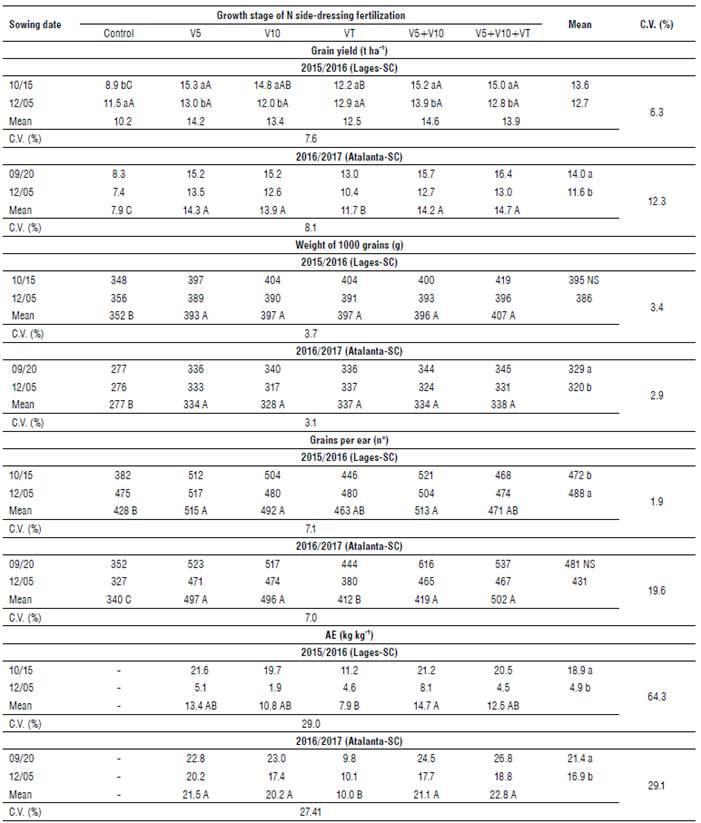
V5 - five expanded leaves; V10 - ten expanded leaves; VT - tassellng, according to the growth stage scale proposed by Ritchie et al. (1993); preferential sowing date - early spring (10/15/2015 and 09/20/2016); Late sowing date - end of spring (12/05/2015 and 12/05/2015); means followed by the same lowercase letter in the column and uppercase letter in the row do not differ significantly by the Tukey test at the significance level of 5% (P<0.05); NS - not signifficant (P≥0.05). C.V. - coefficient of variation.
When maize is grown in early spring, the soil temperature is still low. The low temperature values delay soil organic matter mineralization and decrease the speed of Avena strigosa straw decomposition (Fontoura & Bayer, 2009). Both factors reduce N availability to the crop, enhancing its response to N sidre-dress fertilization.
In the 2015/2016 experiment, grain yield was greater at the preferential sowing date than at the late sowing date when nitrogen side-dressing fertilization was applied at V5 and V10 at one or more growth stages (Tab. 3). An opposite trend was observed in the control without N fertilization which obtained higher productivity when maize was sown in December rather than in October. At both sowing dates, there were no significant differences among treatments with the entire nitrogen rate applied in V5 or V10 and treatments where N side-dressing was split into two (V5+V10) or three (V5+V10+VT) times.
Grain yield was affected by the main effects of the sowing date and nitrogen side-dressing management system in Atalanta (Tab. 3). The treatments with N fertilization in V5, V10, V5+V10 and V5+V10+VT did not show significant differences and were more productive than the treatments without N and with complete fertilization in VT, on the average of two sowing dates (Tab. 4). Grain yield was higher when maize was sown in September than in December, on the average of six nitrogen side-dressing fertilization treatments.
The main hypothesis of this work was based on the results of experiments conducted in the northern hemisphere by DeBruin and Butzen (2014), Kosgey et al. (2013) and Ning et al. (2014). According to this hypothesis, splitting N side-dressing fertilization in order to supply part of the N rate at crop tasseling is an effective stategy to potentialize grain yield when maize is sown at the preferential time at the beginning of spring. The data gathered in Lages and Atalanta did not confirm this hypothesis. Trials carried out by Cardoso et al. (2011), Cruz et al. (2008) and Panison et al. (2019) in different production regions of Brazil also did not detect increments of maize grain yield with the fractioning on N side-dressing fertilization.
The divison of N side-dressing rates at different growth stages with the application of some amount of N fertilizer at VT has a large potential to increase maize grain yield when farmers grow hyper-early hybrids and achieve high kernel productivities (DeBruin & Butzen, 2014). Although the N rate (300 kg ha-1) was defined as aiming to reach yield levels of 21 t ha-1, the maximum grain productivity recorded in the experiment was 16.4 t ha-1. Furthermore, the hybrid P30F53YH does not have a hyper-early cycle and shows great production stability at different enviroments. It is possible that these two characteristics have mitigated the postive effect of splitting N side-dressing fertilization on grain yield in this research. A third factor that may have contributed to the grain yield behaviour is the soil type where the experiments were carried out. At both experimental sites, the soils contain more than 400 g kg-1 of clay (Tab. 1). The chance of having a positive kernel yield response to the splitting of N side-dressing is greater in sandy soils, where N losses by leaching are more pronounced (Cantarella, 2007).
Grain yield was higher at the preferential sowing date than at the late sowing date when nitrogen was side-dressing to the crop. This behaviour is related to the more favorable climatic conditions for reaching high yields, verified when maize is sown at the beginning of spring in southern Brazil (Sangoi et al., 2010). Late sowings decrease maize potential yield due to the low temperatures and less solar radiation available during grain filling (Mundstock & Silva, 2005).
In Lages, the control without N showed higher kernel productivity when the sowing was performed in December rather than in October. Such response emphasizes the effect of the sowing date on nitrogen availability derived from soil organic matter content and Avena strigosa straw decomposition. This effect is accentuated in the highlands of the State of Santa Catarina, which show low soil temperatures at the end of winter (August-September). The higher soil temperatures registered at the end of spring stimulate organic matter mineralization and Avena strigosa straw decay, enhancing N availability for maize development at late sowing dates (Fontoura & Bayer, 2009).
There was a significant increment on maize productivity with the entire N fertilization at VT compared to the control (Tab. 3). Numerically, the yield increase was equivalent to 3.4 and 4.7 t ha-1 at the preferential sowing time, for the growing seasons of 2015/2016 and 2016/2017, respectively (Tab. 4). These data corroborate the statements of DeBruin and Butzen (2014) and Ning et al. (2014), showing that modern hybrids have great capacity to uptake nitrogen during grain filling.
At both growing seasons, control plants produced less kernel weight than the other treatments with N fertilization (Tab. 4). Nitrogen supply is directly related to the crop leaf area index. Maize LAI decreased more drastically during grain filling when N side-dressing was not performed (Fig. 2) which contributed to a decrease of the 1000 grain mass in the control. Such a tendency was also reported by Cruz et al. (2008) and Cardoso et al. (2011). The splitting of N fertilization, combined with the application of % of the N rate at tasseling was expected to delay leaf senescence, increase grain filling duration, and enhance kernel mass, especially at the preferential sowing date. The hyphotesis was not confirmed because there were no significant differences for LAI and 1000 grain mass among treatments with N side-dressing carried out at growth stages one (V5 or V10), two (V5+V10) or three (V5+V10+VT) .
In 2015/2016, the control obtained ears with a lower number of kernels than the treatment with N fertilization at V5 and V10 (Tab. 4). The ears produced fewer grains when maize was sown in October rather than in December, on the average of N side-dressing fertilization treatments. In the growing season of2016/2017, the control and the treatment with complete N side-dressing fertilization in VT obtained ears with a lower kernel number than the other treatments that contributed to the lower yields of these two treatments. This behavior confirms the observations of Bortolini et al. (2000) and Forsthofer et al. (2006), showing that the kernel number per ear is the yield component that affects maize productivity the most.
The agronomic efficiency of nitrogen use (AE) was affected by the main effects of sowing date and nitrogen side-dressing fertilization (Tab. 3). This variable was higher at the preferential sowing date rather than at the late sowing date at both experimental sites, regardless of the nitrogen side-dressing fertilization treatment (Tab. 4). At both experimental sites, the lowest AE values were recorded in the treatment with complete N fertilization in VT. The supply of the complete N rate at maize tasseling can recover partially the damages caused by nitrogen defficiency during the crop vegetative stages. This was confirmed by the weight of 1000 grains behaviour, which did not show statistical differences among the treatments with N fertilization at V5, V10 or VT (Tab. 4). However, the application of the complete N rate at VT could not totally compensate the negative effects of the lack of nitrogen between V5 and VT when the number of ears per plant and the number of potential kernels per ear were defined (Sangoi et al., 2010). Therefore, nitrogen defficiency up to maize flowering reduced grain yield and AE when the whole side-dressing fertilization was performed at VT.
At both growing seasons, the AE values were lower than 25 kg of side-dressing N per kg of kernel (Tab. 4). Mota et al. (2015) and Sangoi et al. (2015) obtained AE values between 30 and 60 under similar experimental conditions, depending on the N rate and source. The lower yield than that planned for the nitrogen rate used (21 t ha-1) in the trials contributed to reduce AE. The low nitrogen efficiency to enhance grain production probably contributed to the differences in the absence of productivity among treatments with complete N fertilization at V5 or V10 and treatments where the side-dressing operation was split into two or three times.
Conclusions
The splitting of N side-dressing fertilization into two (V5+V10) or three (V5+V10+VT) growth stages does not increase maize grain yield or AE, compared to the complete N application at V5 or V10, regardless of the sowing date.
The AE is higher when maize is sown at the beginning of spring, regardless of the nitrogen side-dressing fertilization system.
The complete nitrogen side-dressing fertilization at VT can help to recover partial damages to grain yield caused by no nitrogen aplication during maize vegetative development.
















